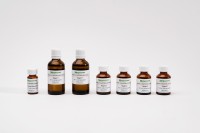| Content: | 5.5 g - 26,000 Units/g |
| Shipping Temperature: | Ambient |
| Storage Temperature: | Below -10oC |
| Formulation: | Supplied as a lyophilised powder |
| Physical Form: | Powder |
| Stability: | > 1 year under recommended storage conditions |
| Enzyme Activity: | Amyloglucosidase |
| EC Number: | 3.2.1.3 |
| CAZy Family: | GH15 |
| Synonyms: | 4-alpha-D-glucan glucohydrolase; glucoamylase |
| Source: | Aspergillus niger |
| Molecular Weight: | 143,500 |
| Expression: | From Aspergillus niger |
| Specificity: | Hydrolysis of terminal α-1,4 and α-1,6 D-glucose residues successively from non-reducing ends of maltodextrins. |
| Specific Activity: |
~ 26,000 U/g (40oC, pH 4.5, soluble starch as substrate). ~ 2,260 U/g on p-nitrophenyl β-maltoside |
| Unit Definition: | One Unit of amyloglucosidase activity is defined as the amount of enzyme required to release one µmole of D-glucose reducing-sugar equivalents per minute from soluble starch at pH 4.5 and 40oC. |
| Temperature Optima: | 70oC |
| pH Optima: | 4 |
| Method recognition: | AOAC Method 2001.03, AOAC Method 2000.11, AOAC Method 2016.06, GB Standards 5009.255-2016 and ISO Standard 15914:2004 |
High purity Amyloglucosidase (A. niger) for use in research, biochemical enzyme assays and analytical testing applications.
Amyloglucosidase. From A. niger. High purity. For use in Megazyme Total Starch and Dietary Fiber methods. Specifically prepared for use in AOAC Method 2001.03 which requires enzymes free of glycerol. This AMG is used in combination with thermostable α-amylase (Cat. No. E-BLAAM) and protease powder (Cat. No. E-BSPRPD). For use, the AMG is dissolved in water at a rate of 1 g/10 mL and 0.2 mL is used per assay. Electrophoretically homogeneous. Lyophilised powder.
Also suitable for use in AOAC 2001.03, AOAC Method 2000.11, AOAC Method 2016.06, GB Standards 5009.255-2016 and ISO Standard 15914:2004.
We have extensive choices for different Carbohydrate Active enZYmes.
Validation of Methods



Extrusion processing of pure chokeberry (Aronia melanocarpa) pomace: Impact on dietary fiber profile and bioactive compounds.
Schmid, V., Steck, J., Mayer-Miebach, E., Behsnilian, D., Bunzel, M., Karbstein, H. P. & Emin, M. A. (2021). Foods, 10(3), 518.
The partial substitution of starch with dietary fiber (DF) in extruded ready-to-eat texturized (RTE) cereals has been suggested as a strategy to reduce the high glycemic index of these food products. Here, we study the impact of extrusion processing on pure chokeberry (Aronia melanocarpa) pomace powder (CPP) rich in DF and polyphenols (PP) focusing on the content and profile of the DF fractions, stability of PP, and techno-functional properties of the extrudates. Using a co-rotating twin-screw extruder, different screw speeds were applied to CPP with different water contents (cw), which resulted in specific mechanical energies (SME) in the range of 145-222 Whkg−1 and material temperatures (TM) in the range of 123-155°C. High molecular weight soluble DF contents slightly increase with increasing thermomechanical stress up to 16.1 ± 0.8 g/100 g dm as compared to CPP (11.5 ± 1.2 g/100 g dm), but total DF (TDF) contents (58.6 ± 0.8 g/100 g dm) did not change. DF structural analysis revealed extrusion-based changes in the portions of pectic polysaccharides (type I rhamnogalacturonan) in the soluble and insoluble DF fractions. Contents of thermolabile anthocyanins decrease linearly with SME and temperature from 1.80 ± 0.09 g/100 g dm in CPP to 0.24 ± 0.06 g/100 g dm (222 Whkg−1, 155°C), but phenolic acids and flavonoids appear to be largely unaffected. Resulting techno-functional (water absorption and water solubility) and physical properties related to the sensory characteristics (expansion, hardness, and color) of pure CPP extrudates support the expectation that granulated CPP extrudates may be a suitable food ingredient rich in DF and PP.
Hide Abstract






















